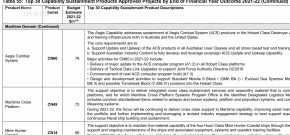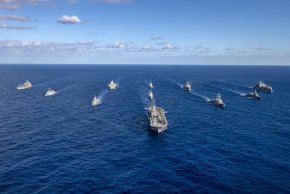Firstly, mods are human. We can make mistakes and misjudgments, we can have different opinions. If you want to report a mod, you can certainly do that, and that mod will be judged by their peers.
Secondly, is it a fantasy fleet?
The challenge thrown down by Marcus Hellyar, is that Australia is spending half a trillion dollars, yet not expecting to see a single new VLS get to sea this decade. He has pieces in the Australian and on ASPI demanding that and pressuring industry, defence and government.
His proposal was more Hobarts and OPV's converted to carry missiles. While logical, is flawed, IMO. Which was IMO both a fairly weak response for the situation we are in, in that it does not add many VLS to the RAN. Also both ships would have numerous problems in terms of build.
My counter proposal was build two full size Burkes. This addresses the getting ship to sea in the remaining 8 years. It also address the lack of VLS by more the doubling the amount of VLS available in the entire RAN and tripling the amount typically on deployment. I also outline a capability need, beyond the platform, as a BMD ship with strong air defence. I proposed an outline of an assessment process to choose a platform, several realistic build options and how they would work within the RAN and where crewing would come from.
In terms of weakness this is certainly one of them. The Hobarts run with about 180 crew. An Anzac or a FFG runs around 180. One of the primary reasons we did not assess a full size burke previously was crewing.
The Burke proposals would run 300 for Maya, closer to 330 for Burke flight IIA or III, and presumed around 300 for the KDX III either Batch I or Batch II. The build proposal was central to specing the ships the same as currently built for other navies, so no increased automation. It may be possible to crew the ships differently, and run them lean, perhaps to ~270. To crew a Burke, we would likely have to pull crews from 3 Anzacs to crew 2 ships. Even then, there would be a shortfall. I suggested growing the RAN and also actively recruiting already trained USN crew, which is a tremendously large pool to draw from. A transfer system could be made with no loss of rank, and RAN salary would be highly attractive. A credible option to cover the ~30 extra needed per ship. Eventually over time, this USN transfer/recruitment could be sustained, to actually long term grown the RAN. The RAN and the USN would be running near identical platforms and crew structures.
We could also take advantage of USN crew training with their shore facilities and embark sailors on their Burkes and have exchanges. This would be attractive to potential Australian sailors, spending early parts of their career in the US on Burkes. Maybe in a location like Hawaii, while we take USN sailors in say Sydney.
Hopefully to gain enough crew to crew additional ships and bring the total up to 14 by the end of the Hunter program in 2050. Being larger crewed would likely still make them more difficult to crew. Although being brand new, and the largest surface combatant in the RAN, is very different from trying to crew something built in the 1960's in the early 2000's.
That doesn't address the sustainable build plan. You would then close or remove the Henderson yard from that sustainable plan. We are also likely to remove Osborne from that sustainable plan. As with half the SSN being built overseas, and total build numbers also likely cut in half, while a larger submarine. The build work in a Burke is extensive, pulling that out of the local build pool would pretty much kill it as it would replace ~ hunters. Then there is who has spare capacity. Both South Korea and Japan are building for themselves first and Australia doing no favours recent about international naval collaboration onbuilds. But if possible, it would get our ships earlier.
Even if much of the fabrication was to happen at the Henderson yard, it is likely much of the Final fitout would need to happen in Osborne. Given the current situation and balance of skills. We are probably looking at modules being made at Henderson + some at Osborne, assembled at Osborne. With final fitout at Osborne. However, if BAE complains about impact to hunter, or isn't interested, hull fabrication could occur at Henderson, and fitout at Osborne/Henderson. We could even lean on the Americans to perhaps have some input/assistance on the build as this would be something that they would be familiar with.
There are no second hand Burkes that I am aware of that are near decommissioning. USS A Burke, recently changed home port to spain, and the USN intends to continue to operate her, and are still acquiring new builds. The Ticonderoga class is being pulled with the last of those coming out around 2030, which would seem to then indicate the first of the burkes retiring around 2030, but that isn't clear. Not really addressing our VLS in this decade challenge. Burkes are big, expensive, crew heavy ships. Not sure how we would feel about jumping into a high mileage one.
The background of all of this is that we are effectively going into a period of conflict. While difficult to crew, such ships would be significant assets during this period. However, post conflict, it may be reasonable for them to have short lives and be decommissioned early, freeing up crews for the last of the hunters around late 2040 early 2050. Avoiding an extensive mid life refit. Restoring the sustainable build program.
I guess this is as much as a discussion of what the RAN would look like if we acquired two Burke ships. There are benefits, VLS load out, capabilities, USN crewing opportunities. But there are issues, including crewing, number of combatants, formulating a complete build program in time to deliver even with a fixed in service design.
For comparison the AWD program ordered 3 ships in 2007, yards selected in 2009, Hobart laid down in 2012, Launched 2015, commissioned 2017. So it is possible to build a destroyer in less than 10 years. Even with all the drama that particular project had.
If instead of building a bigger combatant we wanted to get more smaller but still capable ships, faster. I would be taking a long hard look at the Mogami design. As
@ddxx suggested. In terms of crewing, you could build two Mogami for every Anzac it replaced. Instead of four light covettes, you could have four real frigates. Armed with 16 VLS (which could have ESSM, SM-6), 5", 8 antiship missiles, Searam, hangar, torpedos, they would be capable small ships. For each anzac you replaced you would be gaining 24 new VLS.. The ships would be more open sea worthy and longer ranged with greater than the 7 day endurance of the corvettes being mentioned.





